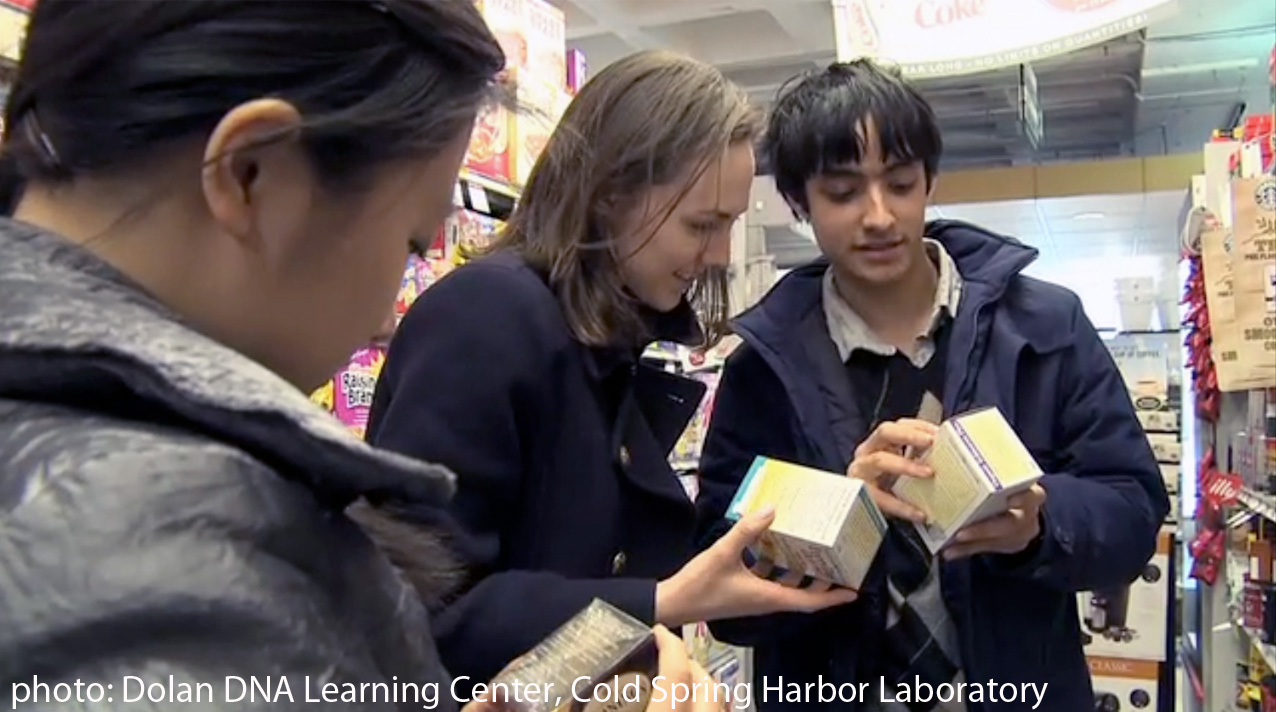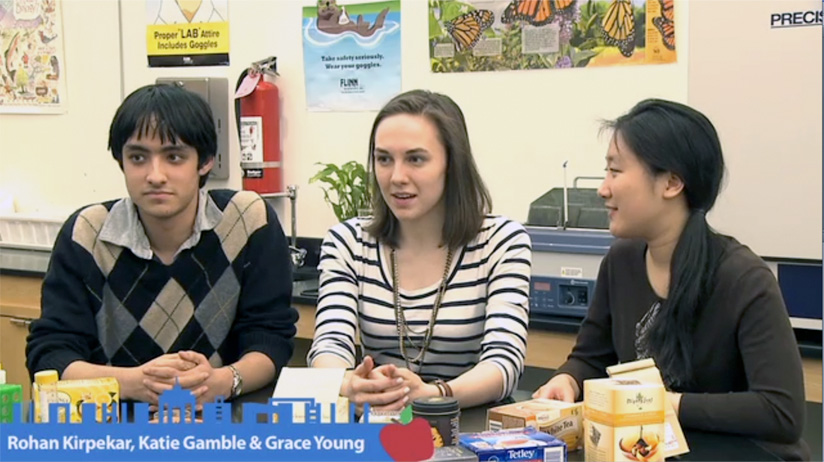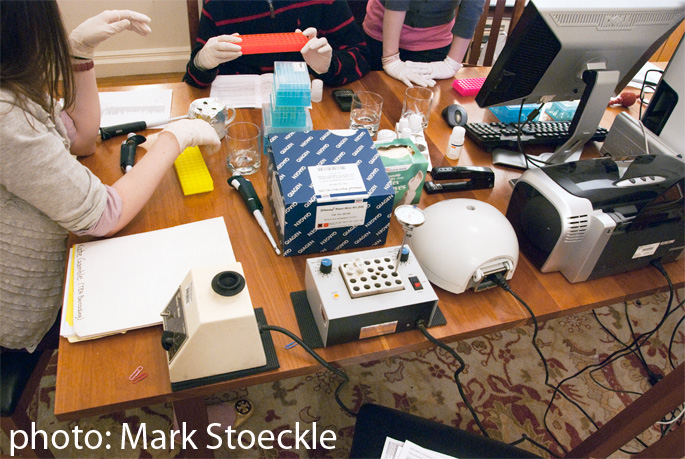TeaBOL: Tea Barcode of Life Project
- Mark Y. Stoeckle, The Rockefeller University
- Catherine C. Gamble, Trinity School
- Rohan Kirpekar, Trinity School
- Grace Young, Trinity School
- Selena Ahmed, Tufts University
- Damon P. Little, The New York Botanical Garden

Grace Young, Catherine Gamble, and Rohan Kirpekar inspect tea labels.
The dried and sometimes cooked or fermented bits of plants used to make teas are not easily identified to species by appearance. We tested whether DNA barcoding can identify the ingredients in commercial tea products.
Key terms
Tea. Infusions prepared from leaves of the tea plant, Camellia sinensis, an evergreen flowering tree native to mountainous regions of southwestern China and neighboring countries.
Herbal “tea.” Infusions prepared from a diversity of other plants.
DNA barcoding. Identifying species using a short DNA sequence from a uniform locus in the genome. For land plants, the agreed-upon standard loci are rbcL and matK.
Summary
Materials and methods.
146 commercial tea products (73 CS and 73 herbal) representing 33 manufacturers, 17 countries, and 82 plant common names, were collected or purchased at 25 NYC locations. DNA was isolated and amlified for barcode-region rbcL and matK. Sequences of amplified products were used to search GenBank database using BLAST.
Results.
Most (90%) of tea products yielded rbcL or matK barcodes using a standard protocol.
Matching DNA identifications to listed ingredients was limited by incomplete databases, shared or nearly identical barcodes among some species, and lack of standard common names for plant species.
21/60 (35%) of herbal and 3/70 (4%) of CS teas generated DNA identifications not found on labels. Some of the surprise “ingredients” were plants used in tea, like chamomile, and some were common weeds or non-food plants, like lawn grass and goosefoot.
Significance.
Unlisted ingredients are common in herbal teas, demonstrating the importance of accessible plant barcoding. Broad-scale adoption may require character-based keys for distinguishing closely-related species.
Our results are published in Nature journal Scientific Reports
Our results attracted press interest
Young Sleuths’ Last Target: Sushi. This Time: Tea. New York Times, August 1, 2011.
Barcode High. The Scientist, November/December 2011.
We followed in the footsteps of prior Trinity student DNA investigators.
- Kate Stoeckle and Louisa Strauss: “Sushi-gate”
- Matt Cost and Brenda Tan: “DNAHouse”
More about TeaBOL

Urban Barcode Project interview

More about Tea
Tea Horse Road: China’s ancient trade road to Tibet by Michael Freeman and TeaBOL investigator Selena Ahmed, River Books Co, Ltd, 2011.
Useful Links
- Barcode of Life Database (BOLD)
- Consortium for the Barcode of Life (CBOL)
- DNA Barcode Blog
- GenBank
- International Barcode of Life Project (iBOL)
- Ten Reasons for Barcoding Life
- NYC Urban Barcode Project
About the Bar Code of Life site
This web site is an outgrowth of
the Taxonomy, DNA, and Barcode of Life meeting held at Banbury
Center, Cold Spring Harbor Laboratory, September 9-12, 2003.
It is managed by Mark Stoeckle at the Program
for the Human Environment (PHE) at The Rockefeller University.
Contact: mark.stoeckle@rockefeller.edu
About the Program
for the Human Environment
The involvement of the Program for the Human Environment in DNA
barcoding dates to Jesse Ausubel's attendance in February 2002
at a conference in Nova Scotia organized by the Canadian Center
for Marine Biodiversity. At the conference, Paul Hebert
presented for the first time his concept of large-scale DNA
barcoding for species identification. Impressed by the
potential for this technology to address difficult challenges
in the Census of Marine Life, Jesse agreed with Paul on
encouraging a conference to explore the contribution
taxonomy and DNA could make to the Census as well as other large-scale
terrestrial efforts. In his capacity as a Program Director of
the Sloan Foundation, Jesse turned to the Banbury Conference
Center of Cold Spring Harbor Laboratory, whose leader Jan
Witkowski prepared a strong proposal to explore both the
scientific reliability of barcoding and the processes that
might bring it to broad application. Concurrently, PHE
researcher Mark Stoeckle began to work with the Hebert lab on
analytic studies of barcoding in birds. Our involvement in
barcoding now takes 3 forms: assisting the organizational
development of the Consortium for the Barcode of Life and the
Barcode of Life Initiative; contributing to the scientific
development of the field, especially by studies in birds, and
contributing to public understanding of the science and
technology of barcoding and its applications through improved
visualization techniques and preparation of brochures and other
broadly accessible means, including this website. While the
Sloan Foundation continues to support CBOL through a grant to
the Smithsonian Institution, it does not provide financial
support for barcoding research itself or support to the PHE for
its research in this field.
